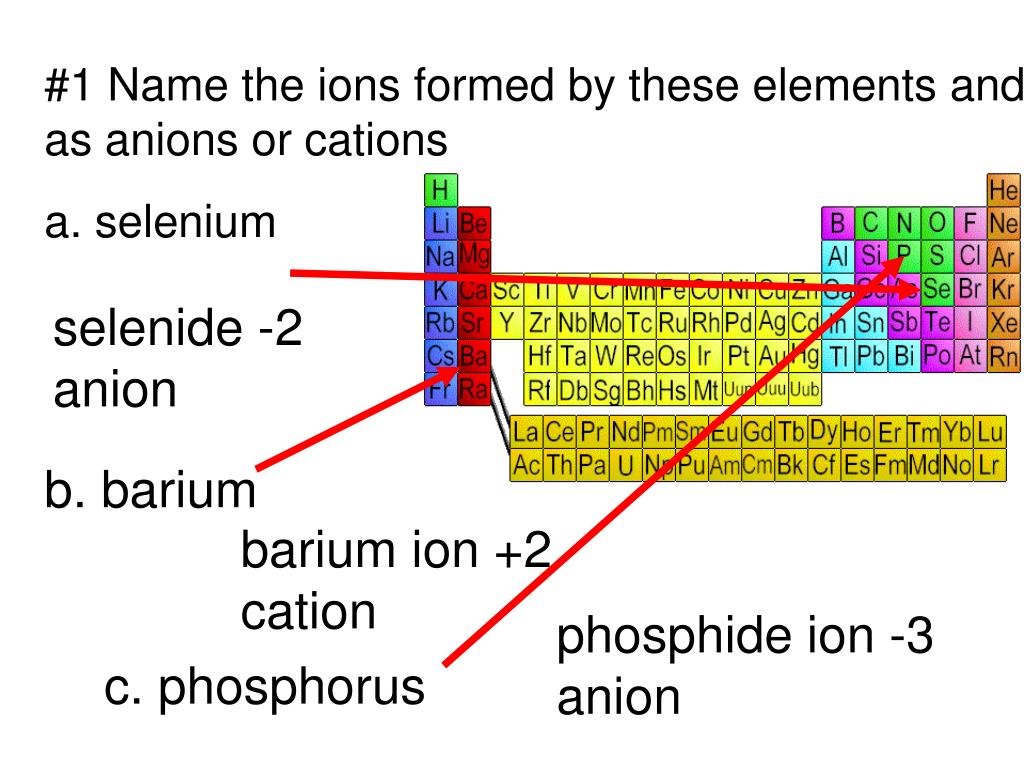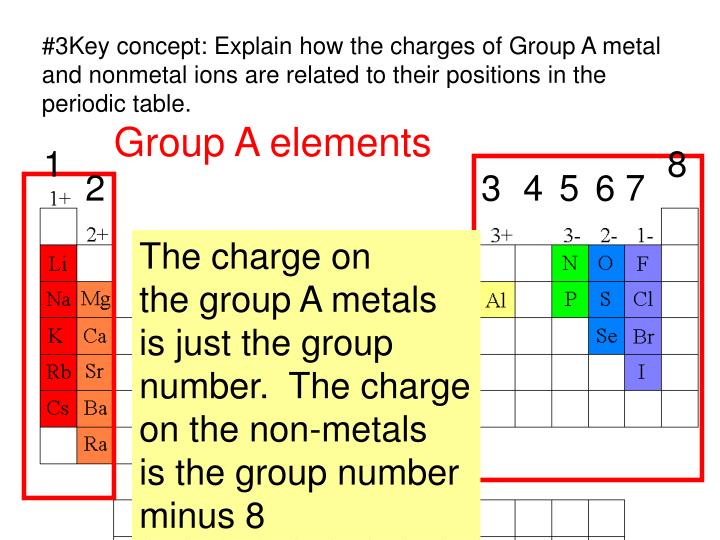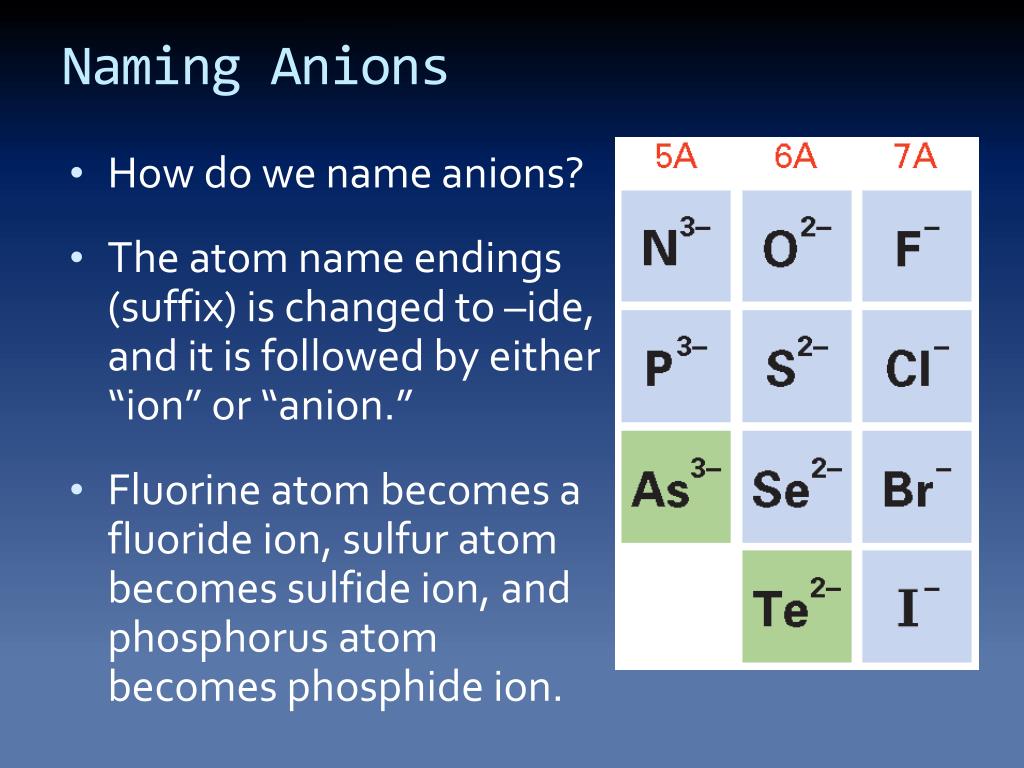What Type Of Elements Form Anions
What Type Of Elements Form Anions - Atoms of group 16 gain two electrons and form ions with a 2− charge, and so on. Web atoms of group 17 gain one electron and form anions with a 1− charge; Atoms are made of three types of subatomic particles: Web moving from the far right to the left on the periodic table, elements often form anions with a negative charge equal to the number of groups moved left from the noble. Some atoms have nearly eight electrons in their valence shell and can gain additional valence electrons until they have an octet. Web moving from the far right to the left on the periodic table, elements often form anions with a negative charge equal to the number of groups moved left from the noble gases. Web forming negative ions (anions) atoms gain electrons in their outer shell when they form negative ions, called anions. These ions are negative because they contain more. Anions are negative ions that are formed when a nonmetal atom gains one or more electrons. For example, sodium makes ionic compounds in which the sodium.
These ions are negative because they contain more. Some atoms have nearly eight electrons in their valence shell and can gain additional valence electrons until they have an octet. Atoms are made of three types of subatomic particles: Web there are two types of ions: Anions are negative ions that are formed when a nonmetal atom gains one or more electrons. Cations and anions to create an ion, atoms gain or lose electrons. Web forming negative ions (anions) atoms gain electrons in their outer shell when they form negative ions, called anions. Removal of the electron gives a cation (left), whereas the addition of an electron gives an. A cation has a net positive electrical charge, which means it has more protons than electrons. Web some common elements that form anions are hydrogen, fluorine, iodine and oxygen.
Oxygen needs to gain two electrons so it forms an anion with a charge of. Web halogens always form anions, alkali metals and alkaline earth metals always form cations. Web there are two types of ions: Atoms of group 16 gain two electrons and form ions with a 2− charge, and so on. Atoms are made of three types of subatomic particles: Web anions and cations hydrogen atom (center) contains a single proton and a single electron. Web negative ions, known as anions, form when an atom gains electrons and now has more electrons than protons, indicating that the number of protons and electrons is not. Two types of ions can be created due to the gain and loss of electrons,. Web for elements in groups. A cation has a net positive electrical charge, which means it has more protons than electrons.
The anion of an element has YouTube
For example, sodium makes ionic compounds in which the sodium. Web some common elements that form anions are hydrogen, fluorine, iodine and oxygen. A sodium atom loses one electron to form a sodium ion forming negative ions Web most of the elements that make ionic compounds form an ion that has a characteristic charge. 1, 2 and 3, the number.
Image result for cations vs anions Chemistry classroom, Electron
Anions are negative ions that are formed when a nonmetal atom gains one or more electrons. Oxygen needs to gain two electrons so it forms an anion with a charge of. Atoms of group 16 gain two electrons and form ions with a 2− charge, and so on. Web negative ions, known as anions, form when an atom gains electrons.
PPT 1 Name the ions formed by these elements and classify them as
Two types of ions can be created due to the gain and loss of electrons,. Web anions and cations hydrogen atom (center) contains a single proton and a single electron. Anions are so named because they are attracted to the anode (positive. Oxygen needs to gain two electrons so it forms an anion with a charge of. Cations and anions.
PPT Naming Compounds PowerPoint Presentation ID3350086
Atoms of group 16 gain two electrons and form ions with a 2− charge, and so on. Web anions are a type of atom, the smallest particle of an element that still retains the element's properties. Two types of ions can be created due to the gain and loss of electrons,. Atoms are made of three types of subatomic particles:.
anion Common anions, their names, formulas and the elements they are
Web most of the elements that make ionic compounds form an ion that has a characteristic charge. Web moving from the far right to the left on the periodic table, elements often form anions with a negative charge equal to the number of groups moved left from the noble. Some atoms have nearly eight electrons in their valence shell and.
PPT 1 Name the ions formed by these elements and classify them as
Removal of the electron gives a cation (left), whereas the addition of an electron gives an. Web metals with the exception of hydrogen, all elements that form positive ions by losing electrons during chemical reactions are called metals. Web there are two types of ions: Anions are negative ions that are formed when a nonmetal atom gains one or more.
PPT Chapter 7 Chemical Formulas and Chemical Compounds PowerPoint
Web some common elements that form anions are hydrogen, fluorine, iodine and oxygen. Atoms of group 16 gain two electrons and form ions with a 2− charge, and so on. Web forming negative ions (anions) atoms gain electrons in their outer shell when they form negative ions, called anions. Web moving from the far right to the left on the.
Which Group of Elements can Form Anions Most Quickly?
Web forming negative ions (anions) atoms gain electrons in their outer shell when they form negative ions, called anions. Some atoms have nearly eight electrons in their valence shell and can gain additional valence electrons until they have an octet. Atoms are made of three types of subatomic particles: Oxygen needs to gain two electrons so it forms an anion.
Naming Simple Ionic Compounds Pathways to Chemistry
Web moving from the far right to the left on the periodic table, elements often form anions with a negative charge equal to the number of groups moved left from the noble gases. Web negative ions, known as anions, form when an atom gains electrons and now has more electrons than protons, indicating that the number of protons and electrons.
PPT IONS PowerPoint Presentation, free download ID2435906
Atoms of group 16 gain two electrons and form ions with a 2− charge, and so on. Two types of ions can be created due to the gain and loss of electrons,. Web moving from the far right to the left on the periodic table, elements often form anions with a negative charge equal to the number of groups moved.
A Sodium Atom Loses One Electron To Form A Sodium Ion Forming Negative Ions
For example, sodium makes ionic compounds in which the sodium. Oxygen needs to gain two electrons so it forms an anion with a charge of. 1, 2 and 3, the number of electrons lost is the same as the group number. Cations and anions to create an ion, atoms gain or lose electrons.
Web Metals With The Exception Of Hydrogen, All Elements That Form Positive Ions By Losing Electrons During Chemical Reactions Are Called Metals.
Web forming negative ions (anions) atoms gain electrons in their outer shell when they form negative ions, called anions. Web there are two types of ions: Anions are so named because they are attracted to the anode (positive. Web atoms of group 17 gain one electron and form anions with a 1− charge;
A Cation Has A Net Positive Electrical Charge, Which Means It Has More Protons Than Electrons.
Web 162k views types of ions: Web negative ions, known as anions, form when an atom gains electrons and now has more electrons than protons, indicating that the number of protons and electrons is not. Web for elements in groups. Web most of the elements that make ionic compounds form an ion that has a characteristic charge.
An Anion Has A Net Negative.
Web some common elements that form anions are hydrogen, fluorine, iodine and oxygen. Web moving from the far right to the left on the periodic table, elements often form anions with a negative charge equal to the number of groups moved left from the noble gases. Two types of ions can be created due to the gain and loss of electrons,. These ions are negative because they contain more.









